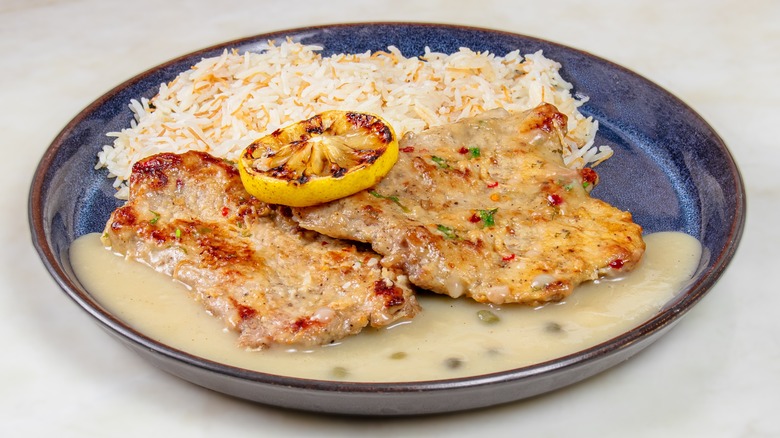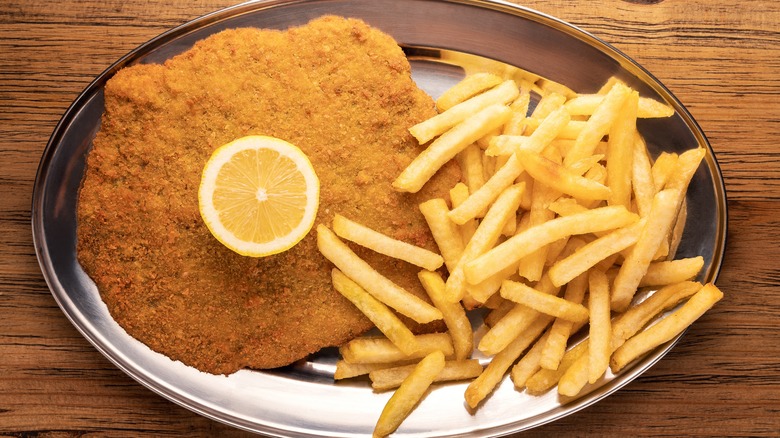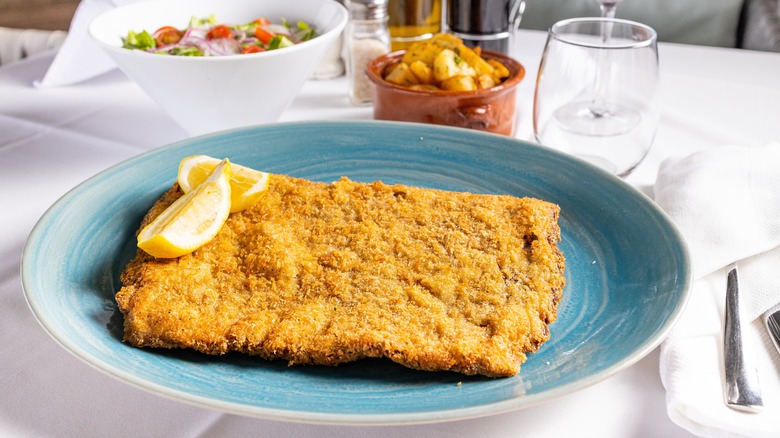Chicken Francese Vs Milanese: Is There A Difference?
Don't let the French-sounding name fool you. Chicken francese is an old school Italian-American restaurant dish that has historical ties to Rochester, New York. Today, it's a fixture on Italian restaurant menus around the New York metropolitan area and beyond. Its counterpart, chicken milanese, might sound a little more old world Italian ("Milan," right?), but the Milan in its name is both a regional label and a cooking technique. So where is a curious foodie to begin differentiating thes recipes, neither of which includes a Sunday sauce, or a red sauce of any kind, for that matter?
Both dishes are wicked impressive, call for inexpensive ingredients, and come together in around a half hour. They are both made with thin portions of poultry that can be cooked in a single skillet (bonus points for cast iron). No need to turn on the oven either, which also makes these flavorful, fragrant chicken dishes great for summertime entertaining. This, however, is about where their similarities end. There are notable differences in preparation and approaches to flavoring. Let's get into it.
What is chicken francese?
Chicken francese (aka chicken française) consists of chicken breasts pounded thin, lightly dredged in flour, dipped in a beaten egg wash, pan-fried, and simmered in creamy white wine sauce. It's similar to chicken piccata but with a thicker sauce. Some recipes add grated Parmesan to the egg wash for a flavorful umami kick. After the battered chicken breast is pan-fried in olive oil, it's spooned with a creamy, luscious pan sauce made from a combination of dry white wine, chicken broth, cream, butter, and lemon juice. The result is an elegant, savory-tart finishing sauce.
To serve, pair chicken francese with a bright arugula salad, roasted asparagus, garlicky escarole, sauteed broccoli rabe, mashed parsnips, or garlic bread. Garnish with caramelized lemon wheels and chopped fresh parsley. For a full-circle presentation, serve your chicken francese with a glass of the same dry white wine you used to make the creamy pan sauce. Pinot Grigio, Chardonnay, and Sauvignon Blanc work well here. Just make sure to opt for a high enough quality bottle that you would actually want to drink a full glass of it. It'll make a world of difference in the flavor of your sauce and, subsequently, the completed dish. Chicken francese is also delicious served with pasta or rice, which can help bulk up the meal for leftovers or make-ahead meal prep.
What is chicken milanese?
Like chicken francese, chicken milanese also starts with pounded-thin chicken breast cutlets that get cooked in a large skillet. Although, unlike francese, chicken milanese gets dredged in flour, egg wash, and Panko breadcrumbs, making for a crunchier texture and savory coating. Once breaded, the cutlets are pan-fried in oil until golden brown, ideally to an internal temperature of 165 degrees Fahrenheit (a meat thermometer can be a lifesaver for successful chicken milanese).
That hot, crispy breaded chicken is kid-friendly and fancy enough for a grown-up dinner party. To complete the meal, pair chicken milanese with a light green side salad dressed in Dijon, bruschetta with tomatoes and fresh basil, roasted potatoes, creamed spinach, fries, or a dollop of fresh burrata and crusty bread. Pro tip: Turn your oven to low heat and use it to keep your completed cutlets warm while you finish frying all of them on the stove.
This dish is strikingly similar to another traditional Italian dish, veal milanese, which is thought to be the gastronomic predecessor of both chicken milanese and chicken francese. In addition to a regional identifier, b"milanese" is a cooking technique that generally refers to breading and frying thin pieces of meat. In these poultry-centric variations, chicken adopts the traditional dish's cooking format while subbing in a more popular contemporary protein. (You can make milanese pork, too, by the way.)
Chicken milanese is breaded and chicken francese is spooned with thick sauce
The most immediately obvious difference between these two chicken-based Italian dishes is that chicken milanese is breaded and chicken francese is not. Also, chicken francese is draped in a lush lemon butter wine sauce, while chicken milanese is commonly seasoned with a light acid component like a squeeze of fresh lemon juice or vinegar. Consequently, chicken francese is a bold lemony bomb of tender chicken in egg batter and mild sauce, whereas chicken milanese is essentially a breaded, fried chicken cutlet.
Another crucial difference between these dishes lies in their preparation. In chicken francese, the meat is pounded to roughly ¼-inch thick, but it can also be sliced crosswise to achieve that thinness. Likewise, the cutlets for chicken milanese should also be ¼-inch thick, but in this case, the pounding may be more crucial because it increases the amount of surface area that can be coated in mouth-watering breading.
Unlike the olive oil that is an integral part of chicken francese, chicken milanese might be fried in a more neutral oil like vegetable, canola, or safflower, resulting in a meatier flavor that lets the seasoned breadcrumbs and chicken lead the profile. Moreover, whereas the egg wash merely lends to a savory coating in chicken francese, in chicken milanese, the egg acts as a binding agent to help the Panko breadcrumbs adhere to the cutlet.



